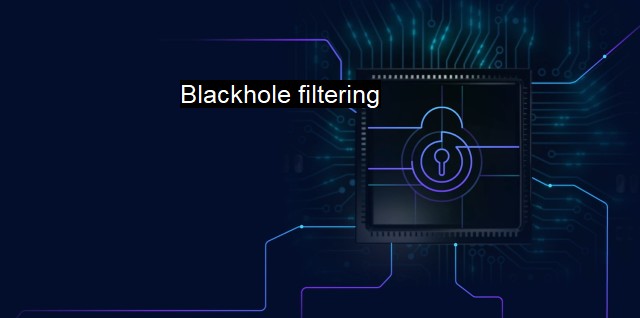What is Blackhole filtering?
The Power of Blackhole Filtering: A Crucial Tool in Cybersecurity and Antivirus Defense
Blackhole filtering, in the landscape of cybersecurity and antivirus applications, is a defense measure employed to thwart and mitigate one form of cyber threats, known as Denial of Service (DoS) attacks. This technique is specifically applicable in situations dealing with a vast range of IP addresses directing an alarming amount of traffic towards particular nodes to compromise network performance. The application of blackhole filtering proceeds in a way where all this unwarranted and suspicious traffic occupationally redirected towards an IP-address-less void, technically referred to as a "blackhole", effectively suppressing the attack and ensuring consistent functioning of the network.The underlying principle of blackhole filtering derives from the concept of 'Sinkhole Routing,' where the traffic incoming from suspicious and untrustworthy IP addresses are manipulated and directed elsewhere. The critical factor distinguishing blackhole filtering is that while Sinkhole Routing might direct traffic to a secondary network for further scrutinization, blackhole routing discards all undesirable traffic. Thus, the blackhole becomes the final destination featuring no 'exit node' and leads to the inevitable loss of all redirected data packets, ensuring protection of the original network.
The process of blackhole filtering enhances the robustness of cybersecurity systems and aids in minimizing and controlling possible damage. The technique proves valuable when targeted attacks aim at exclusively utilizing the network's resources by exhausting bandwidth or overloading server systems. Implementations of blackhole filtering would then promptly and largely alleviate the problem by withdrawing the harmful traffic from the network, thereby preserving network service integrity and availability.
It is noteworthy that the mechanism of blackhole filtering even enables customization to proactively counter incoming cyber threats. Configurations can be made to identify specific tendencies and patterns commonly associated with malicious attacks, like sudden surges of traffic flow from identical IPs or identical kind of data packet requests, etc. Once such harmful patterns are recognized, traffic exhibiting similar attributes can also be directed to be deflected towards the 'blackhole,' increasing the system's surveillance and response efficiency.
It is essential to keep in mind some downsides of blackhole filtering. Though an effective remedy for malicious network traffic, it lacks discrimination in filtering out incoming traffic. Thus, the possibility of valid traffic being labelled suspicious and redirected to the blackhole exists and causes inconvenience. Consequently, false positives often emerge as frequent companions to blackhole filtering implementations.
Also, blackhole filtering depends upon accurate identification and thorough distinction between legitimate and malicious traffic, which requires consistent network monitoring and data analysis. This leads to potential challenges in detecting more subtle, slow-broadcast distributed denial-of-service (DDoS) attacks that do not exhibit typical traffic surge characteristics.
Understanding the world of cybersecurity demands, vigilance about not only the threats but also the mechanisms, such as blackhole filtering, put in place for threat mitigation. It has proved its mettle in diverse scenarios, making it a useful tool for network administrators to remain one step ahead of cyber mischief mongers despite a few caveats. The combination of blackhole filtering with other cybersecurity tools and techniques, regular system updates, and well-informed users can form a formidable defense structure safeguarding the digital universe. Thus, as cyber threats evolve, so must the mitigation strategies and deployment of countermeasures, such as blackhole filtering, edge ever closer to fine-tuned exactness.

Blackhole filtering FAQs
What is blackhole filtering and why is it important in cybersecurity?
Blackhole filtering is a technique used in cybersecurity to block incoming traffic from IP addresses associated with malicious behavior. This type of filtering helps to prevent attackers from gaining access to a system or network through an established connection or spoofed IP address. It is an effective way to protect against malware and other cyber threats.How does blackhole filtering work?
Blackhole filtering works by creating a "blacklist" of IP addresses that are known to be associated with malicious activity. When incoming traffic is received from an IP address on the blacklist, it is automatically blocked before it can reach the intended destination. This technique helps to prevent attacks before they can do any harm to the system or network.Can blackhole filtering be bypassed?
While blackhole filtering is an effective technique for preventing cyber attacks, it is not foolproof. Skilled attackers can use techniques like IP spoofing to bypass the filter and gain access to a system or network. Additionally, blackhole filtering can sometimes result in false positives, where legitimate traffic is mistakenly identified as malicious and blocked.Is blackhole filtering a reliable antivirus solution?
Blackhole filtering is not a complete antivirus solution, but it is an important component of a comprehensive cybersecurity strategy. By blocking traffic from known malicious sources, blackhole filtering helps to reduce the risk of successful cyber attacks. However, it should be used in combination with other antivirus measures, such as antivirus software and firewalls, to provide the most effective protection against cyber threats.| | A | | | B | | | C | | | D | | | E | | | F | | | G | | | H | | | I | | | J | | | K | | | L | | | M | |
| | N | | | O | | | P | | | Q | | | R | | | S | | | T | | | U | | | V | | | W | | | X | | | Y | | | Z | |
| | 1 | | | 2 | | | 3 | | | 4 | | | 7 | | | 8 | | |||||||